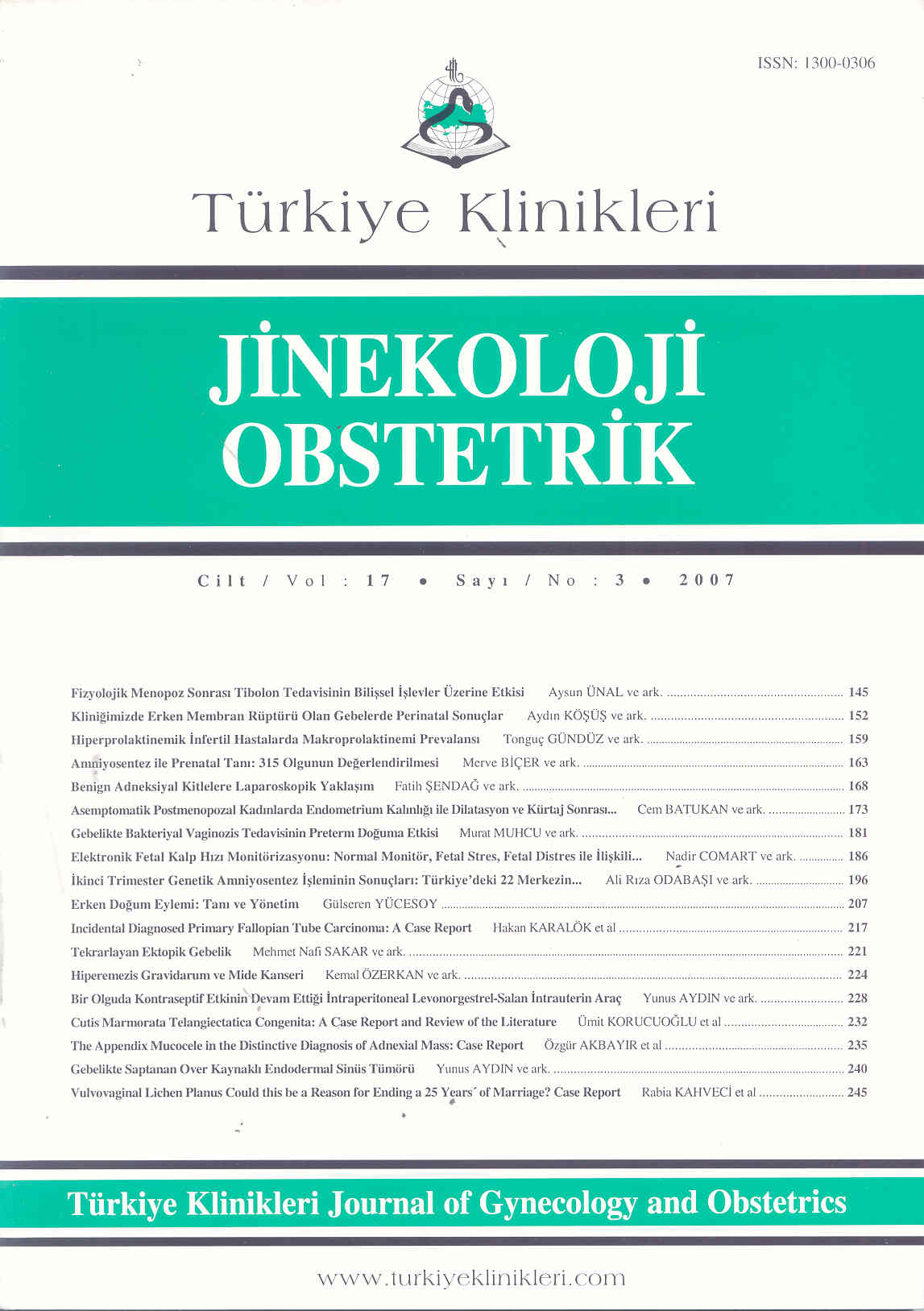Open Access
Peer Reviewed
CASE REPORTS
2172 Viewed1710 Downloaded
Intraperitoneal Levonorgestrel-Releasing Intrauterine Device Maintaining Its Contraceptive Effect: A Case Report
Bir Olguda Kontraseptif Etkinin Devam Ettiği İntraperitoneal Levonorgestrel-Salan İntrauterin Araç
Turkiye Klinikleri J Gynecol Obst. 2007;17(3):228-31
Article Language: TR
Copyright Ⓒ 2020 by Türkiye Klinikleri. This is an open access article under the CC BY-NC-ND license (http://creativecommons.org/licenses/by-nc-nd/4.0/)
ÖZET
Bu çalışmanın amacı; takılma esnasında perfore olarak omentumun serbest ucuna gömülen ve omentum ile birlikte serbestçe hareket eden, buna rağmen kontraseptif etkisini devam ettirdiği düşünülen Mirena uygulanmış vakayı sunmaktır. 36 yaşında hasta ara kanamalarının olması şikayetiyle kliniğimize başvurdu. Doğumlarını sezaryen ile yapmış olan hastaya 23 ay once Mirena takılmış. Transvajinal ultrasonografide IUA (Intrauterin araç)'a ait bulgu izlenmedi. Ayakta batın grafisinde sacrum superior üst kısmı üzerine superpose IUA izlendi. Hastaya laparoskopi uygulandı, batın içerisinde IUA'a rastlanamadı. Operasyon sırasında yapılan skopik inceleme ile IUA yeri tesbit edilemedi. Operasyonun bitimini takiben çekilen batın BT'de IUA'ın umbilikusun 3-4 cm üzerinde transvers kolonun ön kısmında olduğu saptandı. Hastaya bir sonraki gün ikinci kez laparoskopi uygulandı. IUA'ın transvers kolon ön kısmında omentum'a tamamen gömülü olduğu görüldü. IUA çıkartıldı ve operasyon sonlandırıldı. Sunduğumuz vakada Mirena tarafından sağlanan kontraseptif etki lokal mekanizmalar ortadan kalktığı halde devam etmiştir. Bu salgılanan progestagenin sistemik etkisiyle kontrasepsiyonun sağlanabildiğini düşündürmektedir.
Bu çalışmanın amacı; takılma esnasında perfore olarak omentumun serbest ucuna gömülen ve omentum ile birlikte serbestçe hareket eden, buna rağmen kontraseptif etkisini devam ettirdiği düşünülen Mirena uygulanmış vakayı sunmaktır. 36 yaşında hasta ara kanamalarının olması şikayetiyle kliniğimize başvurdu. Doğumlarını sezaryen ile yapmış olan hastaya 23 ay once Mirena takılmış. Transvajinal ultrasonografide IUA (Intrauterin araç)'a ait bulgu izlenmedi. Ayakta batın grafisinde sacrum superior üst kısmı üzerine superpose IUA izlendi. Hastaya laparoskopi uygulandı, batın içerisinde IUA'a rastlanamadı. Operasyon sırasında yapılan skopik inceleme ile IUA yeri tesbit edilemedi. Operasyonun bitimini takiben çekilen batın BT'de IUA'ın umbilikusun 3-4 cm üzerinde transvers kolonun ön kısmında olduğu saptandı. Hastaya bir sonraki gün ikinci kez laparoskopi uygulandı. IUA'ın transvers kolon ön kısmında omentum'a tamamen gömülü olduğu görüldü. IUA çıkartıldı ve operasyon sonlandırıldı. Sunduğumuz vakada Mirena tarafından sağlanan kontraseptif etki lokal mekanizmalar ortadan kalktığı halde devam etmiştir. Bu salgılanan progestagenin sistemik etkisiyle kontrasepsiyonun sağlanabildiğini düşündürmektedir.
ABSTRACT
The aim of this study is to report a case, in which Mirena was possibly perforated during insertion, sunk into the free edge of omentum, moving freely in the abdomen but still maintaining its contraceptive effect. A 36-year-old patient applied to our clinic with the complaint of metrorrhagia. The patient who had given her births through caesarean had Mirena inserted 23 months ago. Transvaginal ultrasonography revealed no signs of IUD in the uterine cavity. Upright abdominal radiography showed that IUD was superposed above the upper part of sacrum superior. Laparoscopy was applied to the patient. IUD was not detected in the abdomen. Scopic abdominal investigation was performed during operation and IUD could not be detected. During the computerized tomography taken after the first session, it was seen that IUD was located 3-4 cm above umblicus, in the transverse meso. Next day, laparoscopy was applied to the patient for the second time. It was recognized that the device had sunk into the omentum. IUD was removed and the procedure was completed. In our case the contraceptive effect by mirena continued even when the local mechanisms were totally eliminated. This led us to the assumption that contraception might still have been provided due to the systemic effect of the progestagen released.
The aim of this study is to report a case, in which Mirena was possibly perforated during insertion, sunk into the free edge of omentum, moving freely in the abdomen but still maintaining its contraceptive effect. A 36-year-old patient applied to our clinic with the complaint of metrorrhagia. The patient who had given her births through caesarean had Mirena inserted 23 months ago. Transvaginal ultrasonography revealed no signs of IUD in the uterine cavity. Upright abdominal radiography showed that IUD was superposed above the upper part of sacrum superior. Laparoscopy was applied to the patient. IUD was not detected in the abdomen. Scopic abdominal investigation was performed during operation and IUD could not be detected. During the computerized tomography taken after the first session, it was seen that IUD was located 3-4 cm above umblicus, in the transverse meso. Next day, laparoscopy was applied to the patient for the second time. It was recognized that the device had sunk into the omentum. IUD was removed and the procedure was completed. In our case the contraceptive effect by mirena continued even when the local mechanisms were totally eliminated. This led us to the assumption that contraception might still have been provided due to the systemic effect of the progestagen released.
MENU
POPULAR ARTICLES
MOST DOWNLOADED ARTICLES





This journal is licensed under a Creative Commons Attribution-NonCommercial-NoDerivatives 4.0 International License.











